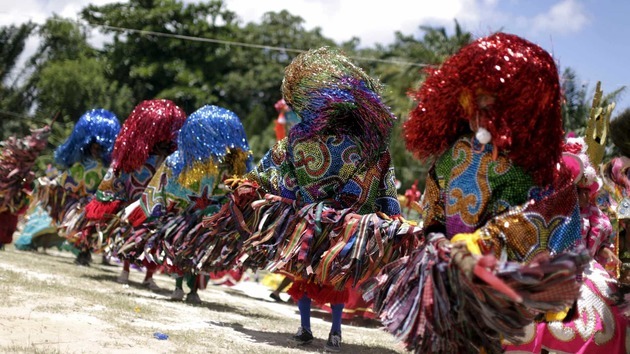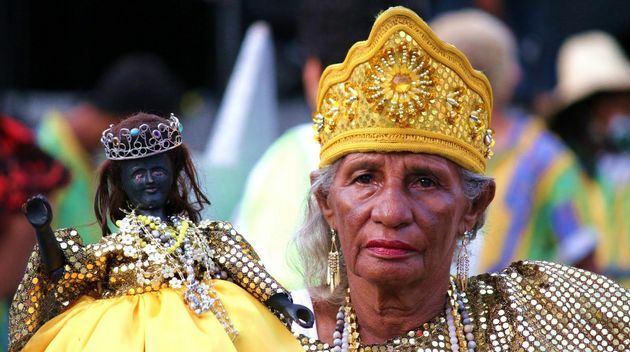Maracatu is a manifestation of Brazilian folklore that involves dance and music.
Its origin dates back to Colonial Brazil and consists of a mixture of African, Portuguese and indigenous cultures.
It is therefore a genuinely Brazilian expression and was created in the state of Pernambuco, being present, above all, in the cities of Olinda, Recife and Nazaré da Mata.

Maracatu Features
- presence of religiosity: characteristics of African religions;
- elaborate dances;
- junction of dance and music;
- colorful and extravagant costumes;
- mixture of African, Portuguese and indigenous cultures.
Spirituality is a characteristic feature in the manifestations of maracatu, and its relationship with African-based religions is present.
The dances, which have similarities with the candomblé, are well elaborated, especially those of the baianas and the ladies of the palace.
Most of the time, it is the women from Bahia who sing, however, everyone can participate in the choir.
Origin: how did Maracatu come about?
Maracatu has an Afro-Brazilian origin and appeared in the state of Pernambuco in the 18th century. It has its oldest expression dating from 1711.
Its origins are uncertain, but they are related to Candomblé and the coronation of the kings of Congo.
The king of Congo was a figure who emerged to administer the black peoples brought to Brazil in order to be enslaved. In this way, the Portuguese colonizers encouraged the tributes paid and used the coronation as a technique of domination.
With its end, the procession appears, which represents a symbolic court and becomes part of Recife's carnival; the same happened with frevo.
Types of Maracatu
There are two types of maracatu: the nation maracatu and the rural maracatu. Learn about these aspects and what makes them different.
Maracatu Nação or Baque Virado
The oldest expression of maracatu is Maracatu Nação, also called Baque Virado. It is done in a procession, where richly dressed black wooden dolls, the so-called dolls, are led.

These mystical dolls are carried by the ladies of the palace and, despite their importance, the king and queen are the main characters of the party. That's because the party is related to the coronation of the kings of Congo.
Maracatu Nation Characters
The dancers of the maracatu nation represent historical characters.

The composition of the cortege, which is formed between 30 and 50 members, always follows an order:
- flag bearer or standard bearer, who dresses in the fashion of Louis XV. The banner, in addition to the name of the association, also includes the year of its creation.
- lady of the court, which are 1 or 2, and which carry the doll.
- doll, the black doll that represents a dead queen.
- Cut, formed by the couple of dukes, the couple of princes and the ambassador. The figure of the ambassador is not mandatory.
- Royals, the king and the queen.
- Slave, which carries a canopy or an umbrella that protects the royalty.
- Yabás, known as baianas.
- feather caboclo, represents the Indians, and is also an optional figure.
- drummers, those who use the instruments, thus being responsible for the rhythm of the dance.
- Catirinas or slaves, dancers who pull the dance.
The king and queen of maracatu are titles conquered in a hereditary way.
Rural Maracatu or Baque Solto
Also known as Baque Solto, this type of maracatu is typical of Nazaré da Mata, a municipality located in the Zona da Mata of Pernambuco.

Its origin appeared later to Maracatu Nação, dating back to the 19th century.
Its participants are basically rural workers. There is a very important figure in this type of aspect, which is the spear caboclo, being the standout character.
He dresses quite characteristically, with a large volume of colored ribbons on his head, a sequined collar and a white flower hanging from his mouth.
Maracatu Nação x Maracatu Rural
Maracatu Nation is typical of Recife's metropolitan area and is the Afro-Brazilian rhythm that has existed for more years. The drummer and the instruments used by him are very important in this type of maracatu.
Meanwhile, the caboclo de lance is the most important figure in the rural maracatu.
While the maracatu nation appears as the procession of an imperial court; in rural maracatu the procession represents the games of rural workers.
Furthermore, there is a distinction in the compositions of the processions and their characters, which differentiates both manifestations.
Maracatu Instruments

In maracatu, percussion instruments are used, such as: boxes, ganzás, gonguês, taroes and drums, known as implements in maracatu.
Wind instruments such as trombones and horns are also used.
Also discover other folklore manifestations of our country!
- Frevo
- Afoxe
- congada
- Samba
- Samba de Roda
- Boom my ox
- Catira
- Gang



